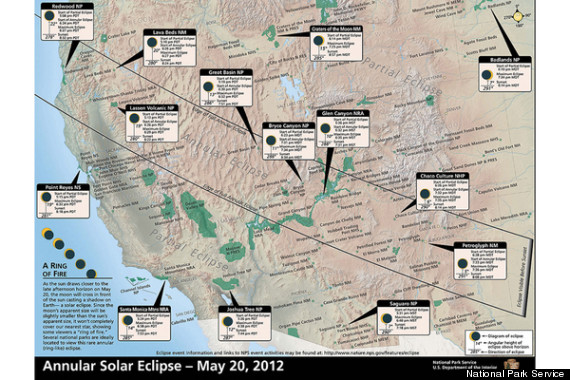
Spectacular Solar Eclipse to Take Place Sunday
Ready for the Eclipse?
Solar Eclipse 2012: National Parks To Give Good View Of Sunday's 'Ring Of Fire'

Spectacular Solar Eclipse to Take Place Sunday
A solar eclipse is expected to be visible across much of the western U.S. on Sunday, and the Griffith Observatory is planning a public viewing.
In the hours before sunset on Sunday, the Earth's moon will pass in front of the sun – the eclipse will be between 5:24 p.m. and 7:42 p.m.
The last solar eclipse visible in the U.S. was in 1994. In Los Angeles, Sunday's eclipse is the most extensive since 1992, according to the observatory.
The Griffith Observatory's telescope will be outfitted with special filters, and viewing-glasses will be available for purchase.
NASA warns that people should never observe a solar eclipse with the naked eye, only through filtered telescopes and special glasses. To learn more about the eclipse, visit NASA's website.
Hiking columnist Reza Gostar recommends heading to Summit Mountain Way or Calabasas Peak for the best local view of the solar eclipse.
http://calabasas.patch.com/articles/spectacular-solar-eclipse-to-take-place-sunday-5d36f327
Ready for the Eclipse?
A partial solar eclipse is expected to darken the sun between 5:16 and 7:40 p.m. Sunday, but astronomers are advising you look ver-r-r-r-y carefully.
How carefully?
Start by turning your back to the sun. Really.
"It is very important that everyone tempted by the sight of 84 percent of the sun's area being covered by the Moon take heed of the warnings you will hear for much of the coming week," Andrew Fraknoi, a frequent radio commentator on all things astronomical.
People can watch by making do-it-yourself pinhole projectors. They view the eclipse by turning their back to the sun and letting the sun shine through the pinhole onto a piece of paper. From there, the progression of the moon's path can be seen.
Viewing the Sun without proper protection is dangerous and can cause serious eye damage. Fraknoi started on Monday by distributing a link for safe eclipse viewing through all his networks.
The experts are also using this as a teachable, festive moment. While it's not a total eclipse, Sunday's event is still pretty special. The last time an "annular eclipse" took place was 18 years ago.
In Los Altos Hills, the Peninsula Astronomical Society will open the Foothill Observatory from 5 p.m. to sunset, and members of the public can safely see the eclipse through the observatory's Hydrogen-alpha and white light telescopes, its newsletter says. (Be prepared to pay $3 in quarters to the parking machine).
In the East Bay, the Chabot Space & Science Center will have an Eclipse Viewing Party for $5, beginning at 5 p.m. the Lawrence Hall of Science in Berkeley will have a viewing for free on its deck, and charge $5 for activities inside. "This will be the best partial eclipse seen from Berkeley until 2045," it says says enticingly on its website. "Don’t miss it. And bring the whole family!"
The San Francisco Amateur Astronomers are hosting two events. One, a viewing party on the Marina Green, promoting safe viewing, and the other, alluringly called the "Ring of Fire Road Trip to Mt. Shasta," which is in the path of the eclipse, and from which the "full annular" effect can be seen.
if you're unprepared, or like to leave things to chance Sunday afternoon, you can even look at the shadows cast by leaves on trees. If there are bug holes in the leaves, they pretty much do the same thing as a pinhole projector, writes Gary Baker in the newsletter of the Peninsula Astronomical Society newsletter.
And while you're under that tree, you might notice what a NASA Science's Science News article says is special about an annular eclipse, described as having "a particular charm of its own." It renders sunbeams into "little rings of light," easily seen in the shadows of a leafy tree.
The NASA article on the partial eclipse quotes NASA's leading eclipse expert, Fred Espenak of the Goddard Space Flight Center, as saying he gives it a '9' on a scale of 1 to 10, In terms of visual spectacles.
For those wondering what places, besides Mt. Shasta, get "the full annular" the Mt. Diablo Astronomical Society posted a link from Bruce Kruse of the Astronomical Society of the Pacific. The interactive Google map, made by Xavier M. Jubier, is worth taking a look to see the path of the eclipse.
This is the first of a "triple-play," Chabot points out. After the annular eclipse on Sunday comes a partial lunar eclipse on June 4 between 2 and 4 a.m., followed by an even rarer once-every-120 years, "Transit of Venus," which is Venus traveling between us and the sun. And yes, your astronomer buddies will be out watching.
DIY: How Can One Watch the Eclipse Safely?
The following is from "Astro-Prof" Andrew Fraknoi: The best way to see the eclipse is to project an image of the sun (and not to look at the sun directly.) One easy way is to make a pinhole projector: Take two pieces of cardboard or thick paper. Put a pinhole in one (taking care to make a clean hole). Then stand with your back to the Sun, and let the Sun’s light fall through the hole and onto the other sheet. You’ll get a small but distinct image of the Sun. (A way to get a sharper pinhole is to cut a square out of the middle of one cardboard, tape a sheet of aluminum foil over the hole and put the pinhole in the foil instead of paper.)
http://menlopark.patch.com/articles/ready-for-the-eclipse-how-to-view-it-safely-bc2590e7
Solar Eclipse 2012: National Parks To Give Good View Of Sunday's 'Ring Of Fire'
By: Nola Taylor Redd, OurAmazingPlanet Contributor
Published: 05/15/2012 03:58 PM EDT on OurAmazingPlanet
When the sun vanishes behind the moon for the first time over the United States in this century, what better place to enjoy the view than from one of the 154 national parks that stand in its path?
Astronomy lovers in the United States will be treated to a partial disappearance of the sun behind the moon this Sunday (May 20). Only the Eastern Seaboard will be totally exempt. Over the course of the solar eclipse, the sun won't vanish completely, but will remain as a ring around the moon for what is known as an annular eclipse. When the eclipse occurs, the moon will be near its most distant point from Earth, making it appear smaller in the sky and thus unable to block the entire sun. But it will still be a stunning sight.
solar eclipse
Thirty-three national parks will see the full effect of the moon's interference. Many western parks will be offering an array of events for their guests, ranging from placing telescopes out for viewing up to a full-scale astronomy festival.
"We're lucky that so many parks happen to lie within the path of the annular eclipse," Grand Canyon park ranger Marker Marshall told OurAmazingPlanet.
A grand event
The Grand Canyon park staff, along with the help of the Tucson Amateur Astronomy Association, will be setting up solar telescopes and helping people safely view the eclipse. NASA scientists will be present to talk about the eclipse, as well as recent lunar findings. They will also have eclipse glasses for sale and will demonstrate how to use binoculars to safely set up a projection of the eclipse on a piece of paper. After the eclipse, the park will host a star party. [Top 10 Most Visited National Parks]
Marshall noted that, like other national parks, the Grand Canyon boasts signs warning people not to look directly at the sun, or to view the sun through telescopes, binoculars or cameras without a solar filter. Doing so will damage your eyes.
At Bryce Canyon National Park in Utah, the annual Astronomy Festival has been moved to coincide with eclipse weekend. Great Basin National Park in Nevada will hold a pre-eclipse party Saturday night with a presentation by an actor playing Galileo, and a special program on Sunday. Several parks will instruct guests on how to make a pinhole viewer of their own to safely observe the eclipse. Several other parks are receiving assistance from their local amateur astronomy clubs to help the public safely watch the show.
Visitors should bring flashlights and jackets, especially if they plan to stay after the eclipse concludes.
"People come to parks to enjoy a dark night sky, and see things like the Milky Way," Marshall said.
"We can really facilitate people seeing even daytime events," she added.
A spectacular view
But Marshall warns that, while the eclipse will make an interesting image, it won't necessarily make a great photograph.
Aiming a camera at the eclipse unprotected could damage it. Hopeful photographers need to add a solar filter to their setup, which will wash out the view of the landscape.
"The casual photographer won't be able to get a photo of the eclipse over the canyon," she said.
Instead, she urges people to enjoy the image captured in their memory.
And there will be plenty of memories made. According to Marshall, all of the campgrounds and hotels around the Grand Canyon that take reservations are booked. Though the first-come, first-serve campgrounds are still available, she anticipates that they, too, will fill quickly, leaving hopeful visitors with a drive of more than an hour to the nearest hotel.
Although only a handful of western parks will receive the full effect of the eclipse, another 125 parks lay along the path of the partial eclipse, where they will provide a stunning view to those not fortunate enough to see the complete show. From Alaska to Minnesota, national parks will catch a partial eclipse or a partial view.
"Astronomy generally is the kind of thing people look for in national parks, so we're glad to help people celebrate it here," Marshall said.










